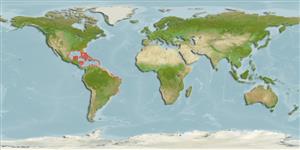| Native range | All suitable habitat | Point map | Year 2100 |

|
| Caranx ruber AquaMaps Data sources: GBIF OBIS |
Length at first maturity
Lm 31.0, range 26 - ? cm
Human uses
Fisheries: commercial; gamefish: yes
Phylogenetic diversity index
(Ref. 82805)
PD50 = 0.5000 many relatives (e.g. carps) 0.5 - 2.0 few relatives (e.g. lungfishes)
Trophic Level
(Ref. 69278)
4.3 ±0.1 se; Based on diet studies.
Resilience
(Ref. 69278)
Medium, minimum population doubling time 1.4 - 4.4 years (K=0.14-0.24; tm=3; Fec=800,000)